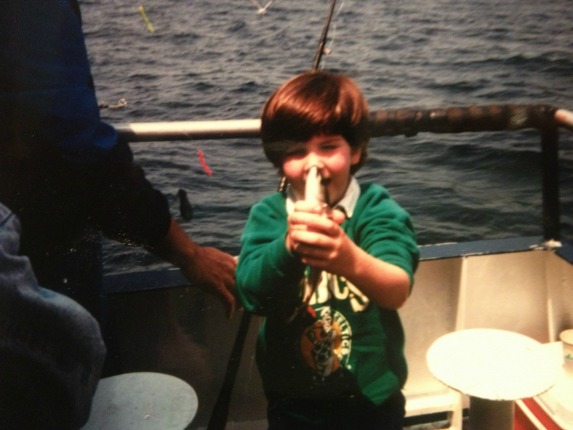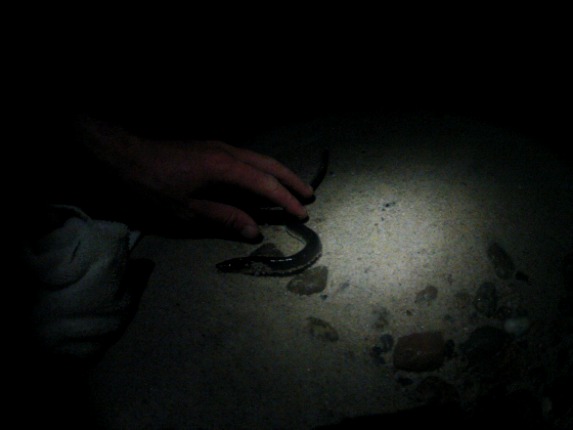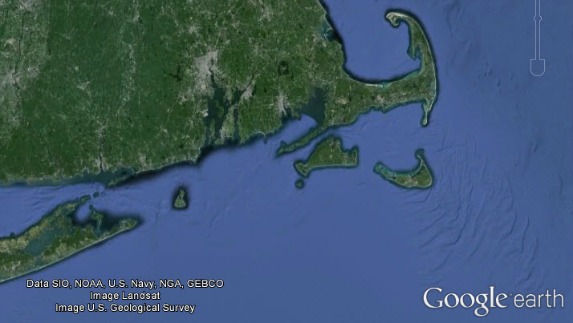In the past few years some enormous striped bass have been brought to the scales. In some instances these fish have weighed more than 70 pounds.
Greg Myerson of Connecticut is one angler who’s caught multiple 70 pound bass in recent seasons, and even a few over 80 pounds.
Yet Connecticut is not the only area producing huge stripers. Plenty of spots here on Cape Cod and throughout New England are coughing up behemoth bass.
Most of us striper addicts would be pleased with a fish of 40 pounds let alone something approaching 100. I have read about early fishermen catching 100 pound stripers in nets and I find it fun to imagine there still being one of these monsters swimming today.
3 Keys To Catching Huge Striped Bass
Catching a huge striper is a challenge I have been faced with since I was a little kid.
Yep that's me at age 6 and since that time, I have been trying to catch a real big fish. I am still a long ways away from the 80 pound mark, but I have caught a few real nice ones.
I know that in my experience, most of the big fish that I catch are caught in virtually the same manner. This seems to be true for other anglers as well.
In other words, catches of really big striped bass seem to have certain things in common.
1) The Fish Is Caught On Live Bait
Most of the real heavyweight bass I hear about are caught on live bait. Fresh dead bait would probably be second best.
Live eels in particular seem to be taking an awful lot of big fish recently.
I just hope that the American eel population can withstand the fishing pressure. Eel populations are at a historical low according to recent research.
A less popular, but potentially just as effective live bait would be the crab.
Here on the Cape, I have used crabs for bait and found crabs in the bellies of many 40 pounders.
In addition to crabs I have also found:
- Lobsters
- Sand dollars
- Mackerel
- Pogies
- Squid
I could go on...
2) The Bass Is Caught In Southern New England
The biggest bass I hear of are consistently coming from southern New England. The stretch from Connecticut to Cape Cod seems to be producing the most heavyweights.
I think someone fishing the stretch from Long Island Sound to Cuttyhunk Island would be in the best position to catch a 100 pound striper.
Cuttyhunk Island (pictured below) is one spot that is pretty notorious for big fish.
Many nice stripers are caught from the Cape Cod Canal and points north. Yet it's been a while since I heard of a bass over 60 pounds.
3) The Fish Is Taken During Late Summer/Early Fall
I think real big bass take a little longer to migrate north. Here on Cape Cod we start to see big bass in the spring, but overall I think late summer/early fall is the best time.
For most of the season the biggest of bass will hang far offshore in areas only accessible via a boat.
This is no problem if you are fishing from a boat. If you fish from the beach, then late summer/early fall is better, because big bass come closer to shore.
I worked Cape Cod's beaches pretty hard this past season. My best success with big fish happened on this trip towards the end of the summer.
In Conclusion
Most fishermen will have to spend years of trial and error before they catch a real nice striped bass. I know that is how it worked for me.
However, I do you think you will increase your odds of success if you incorporate the above 3 observations into your fishing game plan.
If you primarily fish Cape Cod & the Islands, then check out this page for a quick way to diminish the learning curve.
What do you think about targeting big striped bass? Do you agree with the above 3 observations?
P.S. - If you are having a hard time catching your first bass over 40 pounds then leave a comment below. I will do my best to come up with an idea or two for you.







I moved here about two and a half years ago.. I’ve spent very little time striper fishing but the biggest I’ve caught so far is a 22.7 pounder from the Connecticut river ( holyoke dam). But my dream is to catch a 50+ striper… I am open to any tips and tricks u might be willing to guide me towards.
Thanks Nick
Hey Nick – I think anyone who is willing to put in the time has a legit chance of hooking a 50 pounder.
Will you be fishing often during 2014?
From shore or boat?
I like jigging and using top water lures in the canal and I do o.k., but I haven’t caught a bass over 42″ yet. How do I get a 40 pounder in the spring and early summer?
Hey John – how many trips to the Canal do you make during a typical season?
Wonderful tips and information! Thanks!
No problem, happy to help!
Nice article. I have caught a few 40lb fish, but all have come out of the canal. my mission this past year was to find one in the rocks, but that didn’t happen, so I’m keeping that as my primary fishing goal for next year as well.
Thanks Patrick. I like your mission. Definitely more challenging out on the beach front.
I’ll be interested in hearing when you catch that 40!
Hey man yes I am caught some nice ones but no 40 and I cant get it I logged in crazy long and many hours at the canal this year and finally threw eels. Had some luck but no 40
Hey Evan – I hear that a lot actually. Some guys who have been fishing the Canal for years and years, and still nothing over 40 pounds.
What’s your main go-to technique down there at the Canal?
My biggest to date is a 17#, 32 incher … enlighten me! I really haven’t put in a whole lot of time, with the past 2 years really constituting my effort.Mostly surf, a little Canal, and infrequently boat fishing …
Hey Jeff – I’ve been following your progress closely and I think you are doing pretty darn well.
I will admit that it’s a lot easier to catch a 40 pounder from a boat or from the Canal. This past season my largest from the beach was 34 pounds, which I was really excited about.
I’d say fish big plugs, big chunks of fresh dead bait or live eels – all at night from the beach.
I’m happy to help with some more in-depth info if you’d like, so please feel free to post a thread in the forum and I’ll hop right in there.
All good stuff. I like Crazy Alberto’s approach to hunting big bass, which has to do with identifying how the largest stripers feed, and then only presenting offerings that increase the likelyhood of a large hookup. For example a majority of the bass I catch in the canal that are greater than 30# are on a 9″ shad, which is a big lure that consistently catches big fish. Sometimes the numbers caught are low, but when you do hook up it’s normally on a big fish.
Thanks Jon – I think anything Crazy Al says is definitely good advice to follow! He’s quite the fisherman.
I couldn’t agree with your 9” shad comment any more. Great advice and thanks for chiming in.